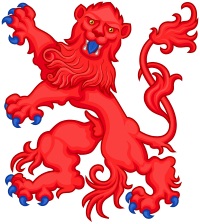Heraldry, "the profession, study, or art of devising, granting, and blazoning arms, tracing genealogies, and determining and ruling on questions of rank or protocol, as exercised by an officer of arms."[1]
Heraldry first began during the High Middle Ages (1000 - 1300) and was originally developed for the purpose of the armory, which usually included a shield, helmet, and crest.[2] Of course throughout time armor gradually fell out of use, but fortunately, heraldic-art remains a respected art form today and has been described as "the handmaid of history."[3]
Before an artist or craftsman can render a Coat of Arms, it must already exist. In other words, the arms must have been designed and recorded by heralds.
 Colbert Coat of Arms [6]
Colbert Coat of Arms [6]Heraldic designs researched by the lay-artist are in many cases inaccurate and portrayed incorrectly. However, to the Heraldic Artist, the same design presents a formidable challenge, whilst they may enjoy considerable freedom within certain limits, the objects in the arms, crest, and supporters, as well as their colors and positions, may not be altered. Although, how each object is rendered provides a wide latitude of design to the artist.[2]
Thus, a Lion Rampant, Gules armed and langued, Azure, can also be fat, thin, hairy, bald, happy, angry, but it must be in the rampant position, colored red, and the tongue and claws of blue.
 Example of a Lion Rampant [4]
Example of a Lion Rampant [4]
Beyond these limits, the artist is free to choose the shape of the shield, style of helm (befitting the rank), and to arrange the mantling to create a well balanced composite design.
The traditional rendering of objects in heraldry is for the most part closely observed, regardless of the modern scientific knowledge. Thus a dolphin is rendered as a fish as it was up until the mid 20th century.
 Example of a Dolphin [6]
Example of a Dolphin [6]
The martlet is another example of the heraldic artist's faithful following to historical designs. Martlets are typically depicted without feet. They were a fairly common bird that followed ships, much like the seagull of today, and because it seemed like they never landed, people thought that they didn't have feet.
.jpg) Example of an English martlet [5]
Example of an English martlet [5]
- ^ "Heraldic Art." Collins English Dictionary - Complete and Unabridged, 12th Edition. Harper Collins Publishers, 2014.
- ^ Fox-Davies, Arthur Charles. A Complete Guide to Heraldry. T.C. & E.C. Jack, 1909.
- ^ Boutell, Charles. Heraldry, Ancient and Modern: Including Boutell's Heraldry. Frederick Warne, 1890.
- ^ "File:Lion rampant guardant - gules.svg." Wikimedia Commons, the free media repository. 2 Jan 2019, 14:14 UTC. https://commons.wikimedia.org/w/index.php?title=File:Lion_rampant_guardant_-_gules.svg&oldid=333168629
- ^ "File:Martlet (English).png." Wikimedia Commons, the free media repository. 20 Oct 2016, 07:45 UTC.https://commons.wikimedia.org/w/index.php?title=File:Martlet_(English).png&oldid=210294199
- ^ Swyrich, Archive materials



.jpg)